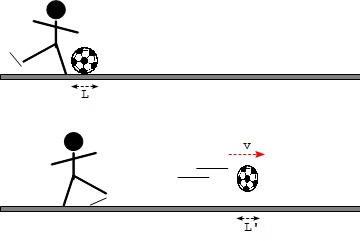Physics Notes - Herong's Tutorial Notes - v3.25, by Herong Yang
Length Contraction - Moving Object Is Shorter
This section provides a quick introduction on length contraction, a phenomenon of difference of object lengths in the moving direction as measured by observers in different inertial frames that are moving relative to each other.
What Is Length Contraction in Special Relativity? Length contraction in special relativity refers to the phenomenon of difference of object lengths in the moving direction as measured by observers in different inertial frames that are moving relative to each other.
The special theory of relativity predicts that if we measure the length of a moving object in the moving direction from a stationary reference frame, and compare it with the length measured from a frame that is moving alone with object, the length measured from the stationary frame will be shorter.
Or we can say that the length of an object measured when it is moving is shorter in the moving direction than the length measured when it is stationary.
Or we simply say that a moving object is shorter, or length of a moving object is contracted.
For example, when we measure the diameter a soccer ball resting on the ground, it is 22 cm. But if you kick it to fly and we measure it from the ground while it is flying, it will be less than 22 cm because of length contraction.
Based on the special theory of relativity, if you can kick it very hard to make it flying at a speed of 0.6*c, the diameter of the ball will be 0.8*22 cm = 17.60 cm in the flying direction, contracted by 20%!

Table of Contents
Introduction of Frame of Reference
Introduction of Special Relativity
Time Dilation in Special Relativity
►Length Contraction in Special Relativity
►Length Contraction - Moving Object Is Shorter
Demonstration of Length Contraction
Length Contraction Formula and Lorentz Factor
Reciprocity of Length Contraction
The Relativity of Simultaneity
Minkowski Spacetime and Diagrams
Introduction of Generalized Coordinates